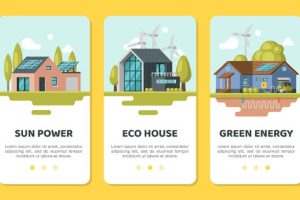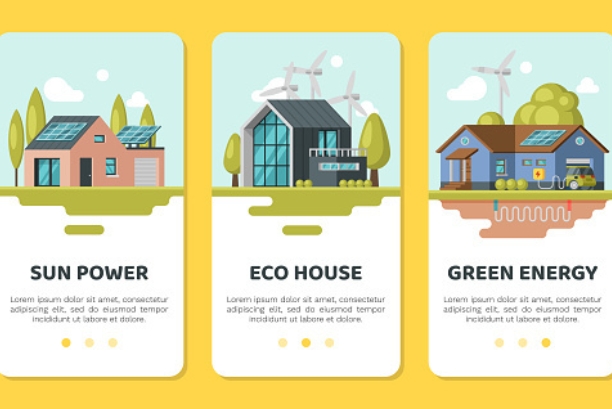The four types of solar energy utilization are photovoltaic solar power, concentrated solar power, solar heating and cooling, and passive solar building design. Solar technology harnesses the sun’s energy in various innovative forms, powering homes, businesses, and even entire cities with clean, renewable energy.
Exploring the sustainable potential of solar energy has led to the development of multiple methods to capture and utilize the sun’s abundant power. Photovoltaic solar power converts sunlight directly into electricity using solar cells. Concentrated solar power, or CSP, employs mirrors or lenses to concentrate a large area of sunlight onto a small area, generating high temperatures that can produce steam to drive turbines for electricity.
Solar heating and cooling systems use thermal energy from the sun to provide hot water, space heating, and cooling for residential and commercial buildings. Lastly, passive solar building design integrates materials and techniques that optimize natural light and heat without mechanical systems, enhancing energy efficiency and reducing costs. Embracing these technologies is pivotal in transitioning to a greener future and mitigating climate change.

Credit: www.sciencedirect.com
Harnessing The Sun’s Power
Harnessing the Sun’s Power transforms how we think about energy. The sun provides a vast, clean, and renewable source of power. Simply put, it is energy waiting to light up our world. Let’s explore how we can capture and use this incredible resource.
The Basics Of Solar Energy
Solar energy is light and heat from the sun, captured using technology. Solar panels are the most popular tools for this job. They turn sunlight into electricity we can use. There are four main types of solar energy use:
- Photovoltaic Systems (PV) – convert sunlight directly into electricity.
- Concentrating Solar Power (CSP) – use mirrors to heat fluids and produce steam.
- Solar Heating and Cooling (SHC) – capture heat for warming air and water.
- Passive Solar Design – uses building design to manage heat from the sun.
Advantages Of Tapping Into Solar Power
Using solar power comes with many benefits. First, it’s environmentally friendly. It reduces the need for fossil fuels. This means cleaner air, water, and less harm to wildlife. Solar energy is also abundant. The sun sends enough energy to Earth every hour to power our global needs for a year! It’s incredibly versatile, too. Solar power can light homes, grow food, power cars, and even run factories. Here’s a quick list of solar power’s advantages:
| Benefit | Explanation |
|---|---|
| Eco-friendly | No harmful emissions |
| Renewable | Infinite source of energy |
| Savings | Reduced energy bills |
| Low Maintenance | Minimal upkeep required |

Credit: www.chegg.com
Photovoltaic Solar Technology
Photovoltaic Solar Technology harnesses sunlight to create clean energy. This innovative approach uses solar panels made of special materials that generate electricity when sunlight hits them. It’s a key player in the renewable energy movement, transforming how we power our lives.
Converting Light To Electricity
The magic starts when photons from sunlight touch the solar panel.
Photovoltaic cells, the building blocks of solar panels, contain silicon among other materials.
These materials have special properties that help free electrons and create electrical current.
This current flows through wires and powers everything from homes to gadgets.
Applications And Scalability
- Home Installations: From rooftops to ground mounts, photovoltaics fit diverse home settings.
- Commercial Use: Businesses reduce energy costs by integrating solar panels.
- Utility-Scale Projects: Large solar farms can power whole communities.
- Portable Solutions: For camping or emergencies, portable solar panels offer flexibility.
Expansion is easy. Start with a few panels and add more as needed.
This modular nature makes solar power a versatile choice for any energy requirement.
Concentrated Solar Power
Imagine using the sun’s heat to create power, much like using a magnifying glass to focus light. That’s what Concentrated Solar Power (CSP) does. It uses mirrors and lenses to bundle sunlight into a powerful heat source. This heat then generates electricity. CSP stands out in the realm of solar energy for its ability to store energy for later use. Let’s explore how CSP harnesses the power of the sun.
Using Mirrors And Lenses
CSP technology focuses on using reflective materials to concentrate solar radiation. These reflective surfaces, such as mirrors or lenses, direct sunlight onto a small area. The concentration process dramatically increases the heat. This heat is then used to produce steam, which powers turbines to generate electricity.
- Parabolic troughs: Curved mirrors focus sunlight on a receiver tube.
- Power towers: Large fields of mirrors direct rays to a central tower.
- Dish engines: Similar to satellite dishes with a receiver at the focal point.
Industrial And Large-scale Use
Concentrated Solar Power is most effective on a big scale. It’s ideal for industrial use or to supply power to a grid. Large CSP plants can store energy, making them reliable even when the sun sets. They deliver power to thousands of homes and businesses. CSP systems are an asset in places with strong sunlight all year round.
- They reduce dependence on fossil fuels.
- CSP plants can produce electricity for up to 24 hours a day.
- The potential for integration with existing power plants exists.

Solar Heating And Cooling Systems
As we harness the power of the sun, Solar Heating and Cooling Systems are critical. They turn sunlight into energy for our homes. In the winter, this keeps houses warm and in the summer, it keeps them cool. It saves money and helps the Earth.
Solar Thermal Energy For Homes
Solar thermal technology captures the sun’s warmth. This heat works for water and space heating. It’s a smart choice for cutting utility bills and reducing greenhouse gases.
- Water heaters: Use solar collectors on rooftops.
- Space heaters: Require a thermal mass to store heat.
- Photovoltaic panels: They can power pumps and fans in these systems.
Installers can place systems on any roof type. They are good for both new homes and older ones.
Climate Control Via Solar
Climate control with solar power is efficient. It works by using the sun’s energy to cool down or warm up a space.
| Solar Cooling | Solar Heating |
|---|---|
| Uses solar thermal collectors | Also uses solar thermal collectors |
| Works with absorption chillers | Depends on radiant floors or thermal walls |
| Reduces reliance on electricity | Lowers the need for fossil fuels |
These systems are scalable, meaning they are perfect for both small and large buildings. Throughout the year, they maintain a comfy indoor climate.
Passive Solar Building Design
Passive Solar Building Design taps into the sun’s energy without using active mechanical systems. It means buildings themselves capture, store, and distribute solar energy as heat in the winter and reject solar heat in the summer. This approach is a simple, predictable, and easy-to-use method to heat and cool living spaces. Basic elements include proper site orientation, window placement, and the use of materials that can naturally regulate temperatures.
Integrating Solar Into Architecture
Integrating solar into architecture turns buildings into power generators. Architects balance aesthetic appeal with functional design to harness the sun’s movement. Homes and buildings get designed with large, south-facing windows and materials like concrete or brick that store heat. The design includes strategically placed shades that block summer sun while maximizing winter sunlight.
Cost-effective And Sustainable Living
Cost-effective and sustainable living is a hallmark of passive solar design. Building costs are similar to traditional construction, but owners save on heating and cooling bills. The design reduces reliance on non-renewable energy sources, cutting down carbon footprints. Passive solar homes often feature high-performance insulation and air sealing, which contribute to long-term savings and comfort.

Credit: www.researchgate.net
The Future Of Solar Energy
The sun beams with limitless potential, ready to power our world – solar energy is about to transform how we live. Innovative technologies promise more efficient ways to harvest sunlight, while the world prepares for a green revolution in power production. The future shines bright as we pivot to cleaner, renewable sources, with solar leading the charge.
Innovations On The Horizon
Solar power is set to take a giant leap forward. Researchers explore new materials to capture sunrays more effectively. Futuristic solar panels emerge, sleek and transparent, blending into windows and surfaces. Energy storage solutions advance rapidly. They ensure that the sunny day’s bounty lasts through the night.
- Thin-Film Solar Cells: More flexible and lightweight than ever.
- Building-Integrated Photovoltaics (BIPV): Turn entire buildings into power producers.
- Solar Skins: Personalize the look of solar installations with aesthetic overlays.
Impact On The Global Energy Landscape
The impacts of solar energy’s growth echo globally. They reshape economies and strategies in energy sectors worldwide. As solar adoption spreads, it champions sustainability. This leads to a decrease in carbon footprints and fosters cleaner environments.
| Region | Impact |
|---|---|
| Asia-Pacific | Massive solar farms feed high energy demands, driving innovation. |
| Europe | Policies embrace solar, propelling energy independence and jobs. |
| Americas | Investments surge in solar technology, bolstering the cleantech sector. |
| Africa | Solar revolutionizes access to electricity, empowering remote communities. |
Frequently Asked Questions For What Are The Four Types Of Solar Energy Utilization
What Are Solar Energy’s Four Main Types?
Solar energy is harnessed in four main ways: photovoltaic (PV) systems, concentrating solar power (CSP), solar heating and cooling (SHC), and passive solar building designs. Each one utilizes solar energy differently, catering to various needs and applications.
How Does Photovoltaic Technology Work?
Photovoltaic technology converts sunlight directly into electricity using solar panels composed of semiconductor materials. When sunlight hits these materials, it excites electrons, creating an electric current.
What Is Concentrating Solar Power?
Concentrating solar power (CSP) systems use mirrors or lenses to focus a large area of sunlight onto a small receiver. This concentrated energy heats a fluid, producing steam that drives a turbine to generate electricity.
Can Solar Energy Be Used For Heating?
Yes, solar heating and cooling (SHC) systems capture solar energy to heat or cool a fluid, often water or air, which is then used to provide space heating, hot water, or cooling for a building.
Conclusion
Harnessing the sun’s power is essential for a sustainable future, and the four types of solar energy utilization offer diverse ways to achieve this. Whether through photovoltaic systems, solar heating, concentrating solar power, or passive solar building designs, each method provides valuable benefits.
As we continue to adopt these technologies, our journey towards clean energy will only accelerate, lighting the way for an eco-friendly tomorrow.

